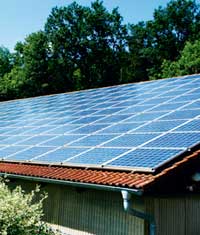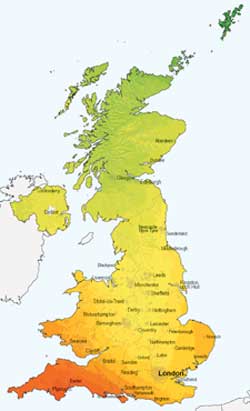Earning an extra income from your roof

The UK government has been set a target of achieving 20% renewable energy by 2020.
To help achieve this, the government has now fallen in line with several other EU states and introduced a feed-in tariff payment (ie a set payment threshold) scheme to increase the uptake of small-scale renewable generation (<5MW).
This will come into force in April next year and will provide electricity producers with a guaranteed payment for each unit of electricity produced by photovoltaic solar panels over a 25-year period.
However, one factor that may put off farmers is the high initial investment for installing the equipment. But this is where INRG Solar comes in, as it is seeking to lease roof space for solar photovoltaic panels.
David Dean of INRG Solar believes there is huge potential in the poultry sector. “South-facing roofs with a 30° angle are ideal for the panels to work at their best.”
The process
 |
|---|
| Solar radiation across the UK ranges from 1300kWh/sq m in the south-west to about 900kWh/sq m in the Shetlands. |
On the question of planning, Mr Dean explains that planning is only needed for panels placed on the ground.
“You don’t need planning permission to put panels on roofs unless your unit is within an Area of Outstanding Natural Beauty (AONB) or is a listed building; if the panels project over the apex of the building; or if the panels’ profile is more than 200mm from the existing roofing material, but it is rare that these elements come to play.”
Even where planning is required, the process is not proving that onerous. The government does not want to see vast sites appear and is favouring micro generation (5MW or less). Therefore it has encouraged local authorities to be compassionate with planning applications and not to let them drag out beyond four months.
Once approval is obtained if required, the panels are tailor made using the building measurements taken at the site to optimise light capture.
“The only cost to the farmer is the solicitor’s fee to check the contract, which is modelled on those used by mobile telephone companies with their masts.”
The farmer then gets a one-off payment plus an annual income from leasing the roof space over the 25-year period. The producer also gets the opportunity to buy the electricity at a reduced rate, thereby saving on energy, he says.
“A typical income, for a suitable, viable roof space of 1000sq m, would result in a £5000 fee on completion and an annual income for 25 years of £1000, plus approximate savings of c20% on all the electricity generated on the roof.”
A typical poultry shed with one side is about 1000 sq m. With multiple shed sites, the income and savings increase in line with the viable roof space.
It doesn’t have to stop at just roof space. A poultry unit with spare derelict land could have panels on the that too, he says. INRG Solar also operates a land-based option to be sited on viable ground space of from 15 acres up to c30 acres which generate sizeable completion and annual rental fees.
In Germany, where a similar scheme has been running for some time, it has expanded into a business with a £10bn turnover. “It has been a saviour for many farms, offering a cash injection.”
“Panels are monitored 24 hours a day, seven days a week remotely from the control centre and if a problem does occur, we send out an engineer to look at it. The farmer does not have to do anything. Maintenance requirements are extremely low with one site visit per year usually proving sufficient.”
On top of the extra income, there is the environmental benefit of being involved in green energy generation.
Initially, the company is looking at the areas south of Manchester, since conditions indicate the south-west and East Anglia can give best panel performance.
So what happens after the 25-year period? “Either producers can start again with another contract or we can remove the panels and leave the shed in its original condition.”
